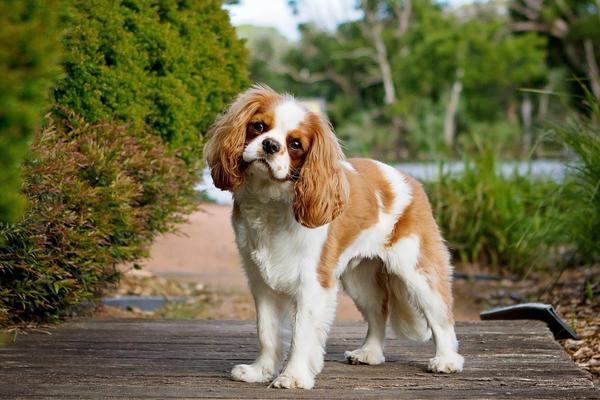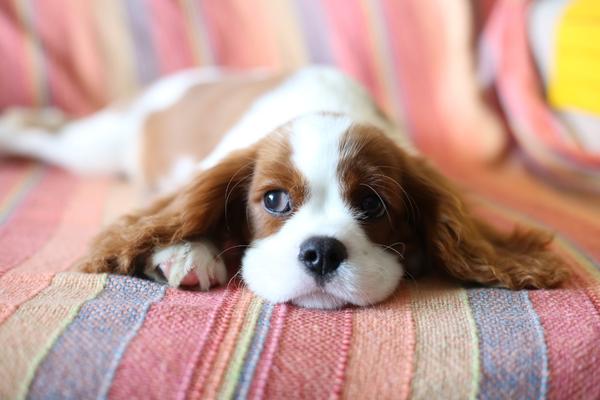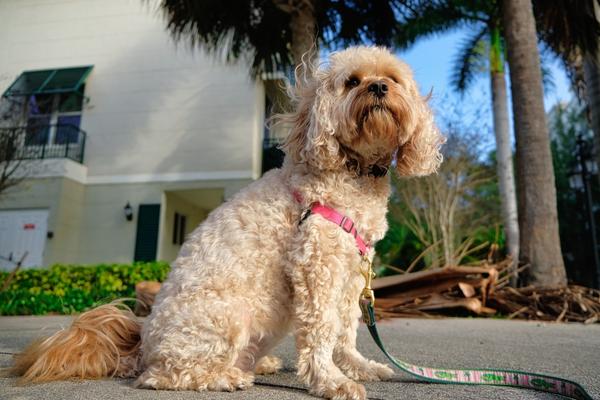Adorable, affectionate, and a popular toy-sized breed, but is the Cavalier King Charles Spaniel hypoallergenic? Unfortunately, it’s a no.
The tiny yet energetic Cav has a single coat and moderately sheds all year round. And, while their silky and colorful fur is part of their charm, their shedding means they aren’t an allergy-friendly breed.
Cavalier King Charles Spaniel Quick Facts

Are Cavalier King Charles Spaniels Hypoallergenic? Contents
With research indicating that approximately 10 to 20% of the US population are allergic to canines, it’s not surprising hypoallergenic breeds are in such high demand.
You may have heard about ‘allergy-free’ dogs and wondered if there really is such a thing. Well, we’re sorry to burst your bubble, no dog breeds are completely allergy-free. Even hairless dogs produce allergens! That’s right — because it’s not the hair that’s the problem.
Dog allergy symptoms are triggered by a protein found in a canine’s saliva, urine, and dander (dead skin cells). The Can F1 to F7 proteins present in drool, dander, and dog pee can become attached to your dog’s fur and released into the air during shedding.
Check out our article What is a Hypoallergenic Dog? — for further info.
The Cavalier King Charles Spaniel has a beautiful coat of medium-length wavy hair, which comes in many different color combos, such as:
- Ruby.
- Black.
- White and tan.
- Blenheim (red and white).
As well as being an attractive patchwork of different colors, the Cavalier’s coat is also luxuriously soft and silky to the touch. This breed only has a single coat, meaning there is no dense undercoat for extra warmth or skin protection.
The big question — do Cavalier King Charles Spaniel shed a lot?
Well, when you compare the Cav to, say, the fluffy Akita or the large German Shepherd, they don’t shed much at all. These two breeds shed heavily all year, and lose even more fur during seasonal shedding. So, you won’t have to deal with half as much fur loss with a Cavalier Spaniel.
That said, these graceful dogs do shed daily, and it’s enough to aggravate allergies.

Firstly.
You can’t prevent your Cav from shedding. It’s an essential part of a dog’s hair growth cycle and no magic grooming regime will stop that hair loss.
However, there are several things you try to limit the level of shedding and keep as much fur as possible out of your home.
1. Brush Every Other Day
As a single-coated breed, de-shedding isn’t an option. But getting into a brushing routine is essential for keeping your Cavalier’s coat healthy and looking its best. Doing this 2 or 3 times a week is all that’s needed to remove tangles and keep shedding under control.
And, if you groom your pooch outside, any dander that’s disturbed will float away in the air and not settle on your carpets and furniture.
2. Bath Your Cavalier Regularly
The Cavalier King Charles can be bathed weekly if necessary, however, around once a month should be ample.
When you bathe your furry friend, remember to use a dog-friendly shampoo and conditioner. Using harsh products can dry out your Cav’s skin, which can lead to more shedding.
3. Feed Them a Healthy Diet
A healthy diet is just as important for dogs as it is for us humans. Our four-legged friends need to eat protein-rich dog food, balanced with the right amount of vitamins, minerals, and carbohydrates.
If your dog is eating filler-laden kibble, they may be lacking sufficient nutrition to grow and maintain healthy skin and fur. If you’re unsure of what food to feed your Cavalier King Charles, your vet will be able to offer professional nutritional advice.
4. Don’t Forget the Omega Fatty Acids
Omega fatty acids are an essential part of your dog’s diet, but your pooch can’t make these important fats by themself. Hence, to make sure your dog is receiving all the benefits of omega 3 and 6 — give them a daily supplement.
You could mix fish oil into wet food, or offer capsules or chewies as a treat. Research shows that omegas help to maintain a healthy and shiny coat, keep the skin moisturized and reduce shedding.
5. Use an Air Purifier
Dog allergens are microscopic, thus circulate inside your house, spreading from room to room — and they aren’t choosy where they settle either. Using an air purifier is a simple way to lower the allergen count and lower your chances of allergies flaring up.
Look for one that includes a HEPA filter. This type can collect/trap larger particles, such as pet hair as well as dander. Thus more effective for removing allergens from your environment.
The Cavalier Spaniel is loved for their adorable appearance and gentle yet playful personality. These dogs can be both active and affectionate and are easy to train and sociable. The good news is, they aren’t the only breeds with this desirable temperament!
If dog allergies affect you, but you want a dog similar to the Cavalier King Charles Spaniel, why not consider one of the following breeds:
A hypoallergenic hybrid mix — Cavapoos are half Poodle and half King Charles Spaniel. Hence, the Cavapoo is the closest breed you’ll find to an allergy-friendly Cav.
Cavapoos love to cuddle and spend as much time as possible with their owners. But, be warned, they’re high energy and can be quite yappy, especially when bored or excited.
You’ll find three different Cavapoo coat types — hair, wooly, and fleece. Cavapoos with the latter will shed the most, but it’s unlikely to be as much as a pure King Charles Spaniel. Wool-coated Cavapoos are the most hypoallergenic — they inherit the tight curls of their Poodle parent and shed very little.
Are Spaniels hypoallergenic? The Cavalier isn’t, but the playful Irish Water Spaniel certainly is. This breed has a curly, medium-length coat and are mild shedders. You can keep your Irish Water Spaniel’s coat in good condition by brushing them weekly and taking them to the groomers regularly to have their curls trimmed.
The Irish is the largest of the Spaniel breeds and weighs significantly more than the toy-sized Cav. These mid-to-large dogs can grow up to 24 inches, and an adult will weigh around 68 pounds — so they’re by no means a lap dog, like the Cav.
The brave and hardworking Irish Water Spaniel enjoys physical activity and can keep walking for hours on end. However, just like the Cavalier, Irish Spaniels are affectionate and make gentle and loving pets.
The Cockapoo is another Spaniel/Poodle crossbreed — this time it’s a Poodle and a Cocker Spaniel. Cockapoos are a low-shedding breed, and were developed to bring more allergy-friendly Spaniel-type dogs to the scene.
In terms of coat, they can have either a flat, wavy or curly coat, and the more Poodle they are, the better for shedding. When a curly Cocka sheds, any dander becomes trapped in their curls. But, you’ll need to brush your dog regularly to deter tangles and release all of the dead hair.
Cockapoos share the affectionate nature of the Cavalier and also have a fun and playful side. Teacup Cockapoos can weigh as little as 2 pounds, but the standard will weigh around 12 to 19 pounds. In comparison, the Cav weighs between 13 to 18 pounds, so on par with the standard Cockapoo.
Conclusion
If you love the thought of living with a Spaniel — without the sneezing fits — all hope is not lost! Many hybrid Spaniel breeds are low shedding and the Irish Water Spaniel is a hypoallergenic purebred.
We’ve provided a mere snippet of the hypo dogs around. Why not check out our list of small hypoallergenic dogs for a few more allergy-friendly breeds.
So, is the Cavalier King Charles Spaniel hypoallergenic? These adorable toy-group tail-waggers have stunning silky coats, but they aren’t a ‘hypo’ breed. Cavs shed all year round and lose too much fur to be allergy-friendly.

Are There Any Hypoallergenic Spaniels?
Some Spaniel breeds are, and others aren’t. For example, the Irish Water Spaniel is hypoallergenic, but the Cavalier King Charles, Cocker Spaniel, and Springer Spaniel are not. Take a look through our dog breeds page to learn how much shedding you can expect.
Do Cavalier King Charles Bark a Lot?
Cavalier King Charles Spaniels are not excessive barkers, but they aren’t silent dogs either. You can expect your Cav to bark when someone is at the door or when they’re excited. And, if you leave your dog alone for too long, they may develop separation anxiety and bark continuously while you’re out.
How Long Do Cavalier Spaniels Live?
The average lifespan of a Cavalier King Charles Spaniel is approximately 12 to 15 years.
Are Cavaliers Lazy Dogs?
Cavaliers have a lot of energy and love to play and explore. That said, they’re also good lap dogs and happy to laze around and cuddle all day. Your Cavalier will adapt to your lifestyle — they can be just as adventurous or just as lazy as you are!
Do Cavaliers Like to Cuddle?
Yes, Cavaliers are affectionate dogs with a loving and gentle nature. Make sure you are giving your pooch enough daily exercise and mental stimulation though. It’s not good for them to become bored little couch potatoes.







